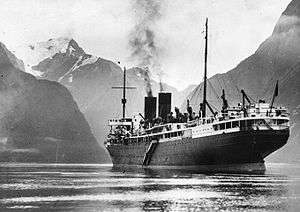HMNZS Monowai (F59)
HMNZS[3] Monowai (F59) was a former Peninsular and Oriental Steam Navigation Company (P&O) merchant vessel. At the outbreak of World War II she became an armed merchant cruiser of the Royal New Zealand Navy (RNZN). She subsequently became HMS Monowai, a Landing Ship, Infantry and mostly operated as a troopship. In 1946 she returned to her old trade as a passenger ship.
 Monowai in Milford Sound in 1933. | |
| History | |
|---|---|
| Name: | SS Razmak |
| Namesake: | Razmak in the Northwest Frontier |
| Builder: | Harland and Wolff |
| Yard number: | 659[1] |
| Laid down: | 1923 |
| Launched: | 16 October 1924 |
| Completed: | 26 February 1925[1] |
| In service: | 1925 |
| Out of service: | 1930 |
| Name: | SS Monowai |
| Namesake: | Lake Monowai.[Note 1] |
| In service: | 1930 |
| Out of service: | 1939 |
| Name: | HMNZS Monowai |
| Acquired: | 21 October 1939 |
| Commissioned: | 30 August 1940 |
| Decommissioned: | 18 June 1943 |
| Identification: | F59 |
| Name: | HMS Monowai |
| Acquired: | 1943 |
| Commissioned: | 18 June 1943 |
| Decommissioned: | August 1946 |
| Fate: | scrapped 1960 |
| Name: | SS Monowai |
| Acquired: | Returned to owners 1946 |
| Fate: | Sold for breaking up 1960 |
| General characteristics | |
| Class and type: |
|
| Displacement: | 10,852 tons gross, 4,925 tons net |
| Length: | 158.2/152.5 m (519/500 ft) |
| Beam: | 19.3 m (63 ft) |
| Propulsion: |
|
| Speed: | 18 knots (33 km/h; 21 mph) max |
| Complement: | 366 as AMC |
| Sensors and processing systems: | SS1 Type Radar[2] |
| Armament: |
|
| Notes: | Davits fitted for 20 LCAs (Landing Craft Assault) for 800 plus troops. Capacity of each 35 troops or 365 kg (805 lb) cargo. |
Civilian career
SS Razmak was built at Greenock yard for P&O by Harland and Wolff, launched in 1924 and completed on 26 February 1925.[1] She was designed for service between Bombay and Aden and spent several years in the Mediterranean Sea. When demand on her original route dried up, she was offered for sale and transferred to the antipodes. The Union Steam Ship Company, part of the P & O group, took her on in 1930 as their second SS Monowai and she ran a subsidized service from Wellington to Vancouver via several Pacific stops. From 24 November 1932 she ran mostly from Wellington to Sydney.
Conversion to armed merchant cruiser
Guns suitable for Monowai had been ordered and stored at the Devonport Naval Base in Auckland. Monowai was requisitioned by the Royal New Zealand Navy on 21 October 1939 and was prepared for mounting the guns. Then followed a period of indecision, and in February 1940 work on her was suspended for over four months. After construction was completed in August 1940, she was commissioned.
The Japanese submarine I-20 conducted an unsuccessful attack on her on 16 January 1942.[4]
Monowai was the first of two ships with this name to serve in the Royal New Zealand Navy. She was named after the New Zealand glacial lake Monowai. Monowai is a Māori word meaning "channel full of water".
Conversion to LSI
As surplus, in 1943 she was transferred to Liverpool in the United Kingdom and handed over to the British Ministry of War Transport. Monowai went to Glasgow for conversion to an "Landing Ship, Infantry (Large)" or LSI(L). From June 1943 to February 1944 she was refitted with completely different armament, capacity for up to 1,800 fully equipped troops, and 20 Assault Landing Craft. She was used during the Normandy landings.
In the later period of the war she was used as a troopship transporting soldiers and after the end of the war in repatriation.
Post war
On 31 August 1946 she was returned to her owner. She resumed merchant service in January 1949 after extensive repair. In 1960 she was sold for breaking up in Hong Kong.
Notes, citations, and references
Notes
- Monowai is a glacial lake in New Zealand. Monowai is a Māori word meaning "channel full of water".
Citations
- McCluskie, Tom (2013). The Rise and Fall of Harland and Wolff. Stroud: The History Press. p. 133. ISBN 9780752488615.
- Mason, Geoffrey B (2007) New Zealand radar development in World War 2
- His Majesty's New Zealand Ship
- Hackett, Bob and Sander Kingsepp (2001) Tabular Record of Movement: HIJMS Submarine I-20
References
- Bell, Andrew; Robinson, Murray (2009). A Tasman Trio: Wanganella - Awatea - Monowai. London: Ships in Focus Publications. ISBN 9781901703559.
- McDougall, R.J (1989). New Zealand Naval Vessels. Government Printing Office. pp. 34–35. ISBN 978-0-477-01399-4.